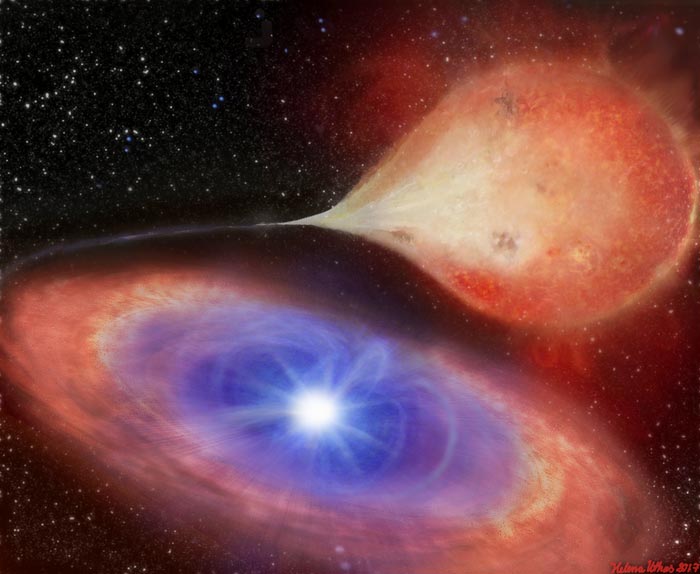Astronomers see white dwarf “switch on and off” for first time

An artist’s impression example of a white dwarf – in this image the white dwarf MV Lyrae – accreting as it draws in material from a companion star.
Credit: Helena Uthas
Astronomers have used a planet-hunting satellite to see a white dwarf abruptly switching on and off for the first time.
The researchers led by Durham University, UK, used NASA’s Transiting Exoplanet Survey Satellite (TESS) to observe the unique phenomenon.
White dwarfs are what most stars become after they have burned off the hydrogen that fuels them. They are approximately the size of the Earth, but have a mass closer to that of the Sun.
The white dwarf observed by the team is known to be accreting, or feeding, from an orbiting companion star.
With the new observations astronomers saw it lose brightness in 30 minutes, a process only previously seen to occur in accreting white dwarfs over a period of several days to months.
The brightness of an accreting white dwarf is affected by the amount of surrounding material it feeds on so the researchers say something is interfering with its food supply.
They hope the discovery will help them learn more about the physics behind accretion – where objects like black holes, white dwarfs and neutron stars feed on surrounding material from neighbouring stars.
The findings are published in the journal Nature Astronomy.
The team observed the phenomenon in the white dwarf binary system, TW Pictoris, which is found about 1,400 light years from Earth.
TW Pictoris consists of a white dwarf that feeds from a surrounding accretion disc fuelled by hydrogen and helium from its smaller companion star. As the white dwarf eats – or accretes – it becomes brighter.
Using the precise observational detail offered by TESS – normally used to look for planets outside our solar system – the Durham-led team saw abrupt falls and rises in brightness never before seen in an accreting white dwarf on such short timescales.
Because the flow of material on to the white dwarf’s accretion disc from its companion star is relatively constant it should not drastically affect its luminosity on such short timescales.
Instead, the researchers believe what they are witnessing could be reconfigurations of the white dwarf’s surface magnetic field.
During the “on” mode, when the brightness is high, the white dwarf feeds off the accretion disc as it normally would. Suddenly and abruptly the system turns “off” and its brightness plummets.
The researchers say that when this happens the magnetic field is spinning so rapidly that a centrifugal barrier stops the fuel from the accretion disc constantly falling on to the white dwarf.
During this phase the amount of fuel the white dwarf is able to feed on is being regulated through a process called magnetic gating.
In this case, the spinning magnetic field of the white dwarf regulates the fuel passing through a “gate” on to the accretion disc, leading to semi-regular small increases in brightness seen by the astronomers.
After some time, the system sporadically turns “on” again, and the brightness increases back to its original level.
Lead author Dr Simone Scaringi, in the Centre for Extragalactic Astronomy, at Durham University, UK, said: “The brightness variations seen in accreting white dwarfs are generally relatively slow, occurring on timescales of days to months.
“To see the brightness of TW Pictoris plummet in 30 minutes is in itself extraordinary as it has never been seen in other accreting white dwarfs and is totally unexpected from our understanding of how these systems are supposed to feed through the accretion disc. It appears to be switching on and off.
“This really is a previously unrecognised phenomenon and because we can draw comparisons with similar behaviour in the much smaller neutron stars it could be an important step in helping us to better understand the process of how other accreting objects feed on the material that surrounds them and the important role of magnetic fields in this process.”
As white dwarfs are more common in the Universe than neutron stars, the astronomers hope to look for other examples of this behaviour in future research projects to learn more about accretion.
The research was funded in the UK by Durham University. The research team also included the Italian National Institute for Astrophysics, the South African Astronomical Observatory, the University of Cape Town and the University of the Free State, both also South Africa, Radboud University, The Netherlands, the University of Southampton, UK, and the University of Notre Dame, USA.
Journal: Nature Astronomy
DOI: 10.1038/s41550-021-01494-x
Method of Research: Observational study
Subject of Research: Not applicable
Article Title: An accreting white dwarf displaying fast transitional mode switching
Article Publication Date: 18-Oct-2021
Media Contact
Leighton Kitson
Durham University
leighton.kitson@durham.ac.uk
Office: 1-913-346-074
All latest news from the category: Physics and Astronomy
This area deals with the fundamental laws and building blocks of nature and how they interact, the properties and the behavior of matter, and research into space and time and their structures.
innovations-report provides in-depth reports and articles on subjects such as astrophysics, laser technologies, nuclear, quantum, particle and solid-state physics, nanotechnologies, planetary research and findings (Mars, Venus) and developments related to the Hubble Telescope.
Newest articles

Scientists transform blood into regenerative materials
… paving the way for personalized, blood-based, 3D-printed implants. Scientists have created a new ‘biocooperative’ material based on blood, which has shown to successfully repair bones, paving the way for…

A new experimental infection model in flies
…offers a fast and cost-effective way to test drugs. Researchers at the Germans Trias i Pujol Research Institute and Hospital have reinforced their leading role in infectious disease research by…

Material developed with novel stretching properties
KIT researchers produce metamaterial with different extension and compression properties than conventional materials. With this material, the working group headed by Professor Martin Wegener at KIT’s Institute of Applied Physics…



